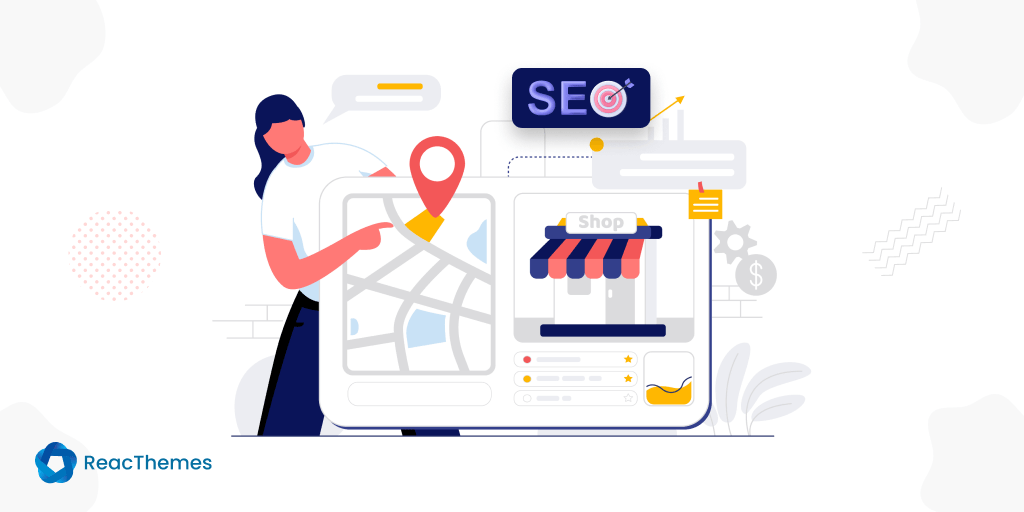In the competitive world of e-commerce, standing out is crucial, especially for businesses with multiple physical locations. Local SEO is a game-changer for these businesses, driving more traffic from local customers searching for products you offer.
By implementing a strategic local SEO approach, you can significantly increase local visibility, attract in-store visits, and boost sales. This guide will equip you with the best local SEO strategies specifically designed to supercharge your multi-location e-commerce business.
So, without further ado, let’s dig deeper.
What are The Benefits of Local SEO for Multi-Location eCommerce Businesses?
There are several benefits to implementing a local SEO strategy for multi-location eCommerce businesses:
i. Increased local visibility
Local SEO helps your business show up in search results for people in the areas you serve. This is especially important for searches with local intent, like “[product] near me” or “[service] in [city]”. By ranking well locally, you’ll be more likely to be seen by potential customers who are ready to buy.
ii. Targeted traffic
Local SEO attracts customers who are more likely to convert. People searching for local businesses are usually closer to the buying decision stage compared to those doing general searches.
iii. Boost credibility and trust
A strong local SEO presence, including optimized Google My Business listings and positive online reviews, builds trust and credibility with potential customers.
iv. Improved brand awareness
Local SEO helps you establish your brand within your local communities. The more you show up in local searches, the more familiar customers become with your business.
v. Cost-effective marketing
Compared to traditional advertising methods, local SEO can be a more cost-effective way to reach new customers, especially since many local SEO tactics can be done in-house.
5 Local SEO Strategies for Multi-Location eCommerce Businesses
Optimizing local SEO for multi-location eCommerce businesses involves several key strategies to improve visibility and attract relevant customers. Here are five effective approaches:
1. Localized keyword targeting
Tailor your website content and product descriptions to include location-specific keywords relevant to each store’s area. Conduct keyword research for each location to identify popular search terms related to your products or services, combined with local identifiers.
2. Create location-specific pages
Develop individual landing pages for each store location. Include unique content such as the store address, phone number, business hours, and customer reviews. Optimize these pages with local keywords and ensure consistency across NAP (name, address, phone number) information.
3. Google my business optimization:
Claim and optimize Google My Business (GMB) profiles for each store location. Provide accurate information about your business, such as store hours, categories, and photos. Encourage customers to leave reviews, which can boost local search rankings.
4. Local link building
Build links from local websites and directories to your store locations. Seek partnerships with local businesses, sponsor local events, or contribute guest posts to local blogs. These efforts can improve your website’s authority within specific geographic areas.
5. Use structured data markup
Implement structured data markup on your website to help search engines understand your business locations. Use schema.org markup to specify addresses, business hours, and contact information for each store. This can enhance the visibility of your stores in local search results.
How to Measure The Success of a Local SEO Strategy for Multi-Location eCommerce Businesses
Measuring the success of a local SEO strategy for multi-location eCommerce businesses involves tracking specific metrics and analyzing various performance indicators. Here’s how you can effectively measure the impact of your strategy:
i. Local search rankings
Monitor the rankings of your store locations for targeted local keywords. Use tools like Google Search Console, SEMrush, or Moz to track keyword positions across different locations. An increase in rankings indicates improved visibility in local search results.
ii. Organic traffic
Analyze organic traffic to each store’s location-specific pages. Use Google Analytics to view traffic sources and behavior metrics (like bounce rate, session duration, and conversions) for visitors coming from local search queries. Increasing organic traffic suggests improved SEO performance.
iii. Google My Business insights
Regularly check the insights provided by Google My Business for each location. Monitor metrics like search impressions, clicks to call, direction requests, and photo views. A rise in these metrics indicates increased local visibility and user engagement.
iv. Local engagement metrics
Evaluate local engagement metrics such as customer reviews, ratings, and comments across different platforms (Google, Yelp, Facebook, etc.). Positive reviews and higher ratings demonstrate improved brand reputation and trustworthiness within local communities.
v. Local conversions and sales
Track conversions and sales attributed to each store location. Set up conversion tracking in Google Analytics to monitor online purchases, store visits, or other desired actions originating from local search traffic. Increasing conversions indicate a successful local SEO strategy.
vi. Local citation and backlink growth
Measure the growth of local citations (mentions of your business name, address, and phone number) and backlinks from local websites. Tools like Moz Local or Ahrefs can help monitor citation consistency and backlink acquisition over time.
vii. Customer feedback and surveys
Gather direct feedback from local customers through surveys or feedback forms. Understand their awareness of your brand and the effectiveness of your local SEO efforts in reaching and engaging them.
Common Mistakes to Avoid When Optimizing Google Business Profile for Multi-Location eCommerce Businesses
Here are some common mistakes to avoid when optimizing Google Business Profile (GBP) for multi-location eCommerce businesses:
- Not creating separate GBP listings for each location. It’s important to have a distinct listing for each physical store location to avoid confusing customers and search engines.
- Inconsistent NAP (name, address, phone number) across listings. Ensure the NAP is exactly the same on your website, GBP, and other online directories for each location. Inconsistencies can hurt local SEO.
- Failing to fill out all details for each location. Provide complete and accurate information like business hours, photos, services, and attributes for each location. Incomplete listings perform poorly.
- Not verifying each location. You must verify each location via postcard, phone, or other methods before GBP will publish the listing. Unverified listings are hidden.
- Lack of regular updates and posts. Use Google Posts consistently to highlight events, offers, and content for each location. Stale listings get less visibility.
- Not encouraging reviews for each location. Actively ask customers to leave reviews on your GBP listings. Reviews are a key ranking factor and build trust.
- Failing to monitor GBP insights for each location. Track how customers find and interact with each listing to identify optimization opportunities.
- Not providing access to location managers. Give store managers the ability to update hours, answer questions, and respond to reviews for their location.
Conclusion
The digital landscape is constantly evolving, so remember, local SEO is a slow process. By consistently implementing these strategies, monitoring your results, and adapting to new trends, you’ll establish a strong online presence across all your locations.
This dominant local SEO position will not only bring in more customers through targeted online searches but also solidify your brand reputation within each community you serve. In essence, you’ll become the go-to e-commerce destination for local customers, driving long-term success for your multi-location business.








